Everything You Need to Know About Concrete Trowels
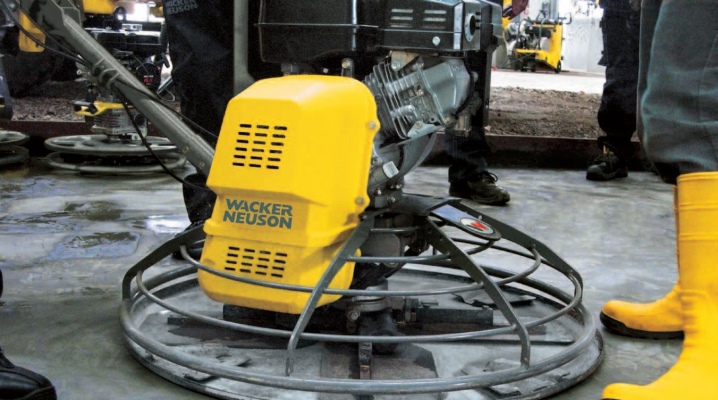
Special concrete trowels are used to level the concrete floor before the finishing is laid. They are also called grinding helicopters. They are available in various modifications, equipped with an electric, gasoline or diesel engine. The equipment has various technical characteristics and operational properties that must be taken into account when choosing.


What it is?
A concrete trowel is a highly specialized equipment designed for arranging a concrete surface at production facilities, parking lots, warehouses, park areas. With its help, you can quickly and with minimal effort to make the base even, without pits, bumps and other irregularities and external defects.
Grinding units are used to obtain a smooth concrete surface without additional coating or for a semi-dry screed for further finishing.
All manual grouting helicopters have a similar design. It includes:
- a frame on which the drive with rotors is fixed;
- engine;
- articulated-movable bar;
- rotor;
- protective ring;
- handles with a located device for controlling the unit.

Regardless of the types of devices, they all have a similar principle of operation: the blades act on the surface to be treated with different speed and force, due to which the base is leveled and becomes perfectly smooth. Initial grinding is performed with small rotations of the disc, which allows you to get rid of large flaws. Subsequent processing is carried out at a high speed of rotation of the blades.



Classification
On sale meet professional and household units - pneumatic grinders for concrete, natural or artificial stone.
The latter are distinguished by their small size and weight - the mass of various models ranges from 2 to 6 kg. These miniature units are easy to operate due to their small weight and dimensions and high maneuverability.
They are often used for sanding putty on wall and ceiling surfaces.


Plastering machines are able to quickly eliminate trowel marks, sagging and other external imperfections that may be noticeable after painting. This compact equipment is convenient to use for plastering walls in both small and spacious rooms.
Professional equipment is distinguished by its large dimensions, weight, power and performance compared to household appliances. Such units are designed for work on large construction sites. They are classified according to the number of rotors and the type of motor.


By the number of rotors
Devices are single-rotor and double-rotor. The first ones are intended for grouting small areas - up to 500 m2. Single-rotor models, in comparison with two-rotor ones, have lower weight and dimensions. Their weight ranges from 43 to 103 kg.
They are distinguished by their budget price, ease of transportation to the construction site and economy - thanks to these advantages, 1 rotor devices are in great demand.
Single-rotor units are equipped with working discs with a diameter of 600 to 1200 mm. Most models have a gasoline engine, but electric units are also on sale.Electrically driven devices are most often used for indoor operation with insufficient or no ventilation. They are connected to 220 or 380 V. One-rotor "helicopters" are equipped with an electric motor with a power of 750-2000 W.
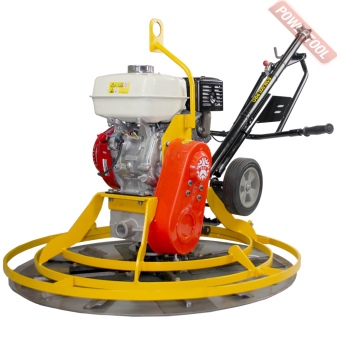
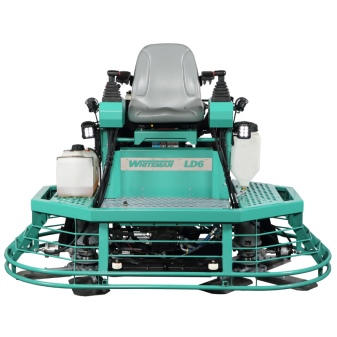
Equipment with 1 rotor can also be equipped with a gasoline engine (internal combustion engine). These are the most popular models of trowelling "helicopters". The weakest cars in terms of power are equipped with a 4 liter engine. with.
Two-rotor units are more efficient, which is why they are recommended to be used for grouting objects of large areas.
Such models are made in the form of autonomous self-propelled vehicles. It is advisable to use them when processing concrete screeds with an area of 700 m2 or more.
The two-rotor models are equipped with an operator's seat, which is located in the center of the machine. Levers or joysticks are provided to change the direction of movement of the equipment. These cars are equipped with powerful headlights located at the front and rear. Thanks to the provision of good illumination, the units can be operated in poor light or in the absence of it.


Devices with 2 rotors are large and heavy. Depending on the model, their weight is 300-700 kg. Due to its weight, the loading and unloading of equipment should be carried out using specialized equipment with an appropriate carrying capacity. To facilitate the movement of machines to a construction site, manufacturers equip "helicopters" with 4 wheels.

By engine type
Concrete screed machines are equipped with an electric, gasoline or diesel engine. Each of them has its own advantages and disadvantages.
- Electrically driven devices are of medium power. They are suitable for interior work. Due to the absence of exhaust gases, they can be used in unventilated rooms. Compactness and lightness make these devices maneuverable. Their disadvantages include dependence on the electrical network and the limited range of action by the length of the cord. If it is necessary to use an electrically powered "helicopter" in the field, a generator will be required.
- Gasoline concrete screeds are designed for outdoor use. In closed rooms, they may only be used if there is good air ventilation. Such equipment has an average performance.
- Diesel engines are most often equipped with powerful self-propelled units. The technique is distinguished by high indicators of power and productivity. Diesel grouting machines are considered the most expensive - this is their significant drawback.

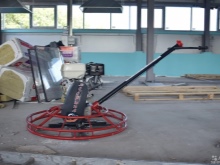

The choice of the engine will directly depend on the volume of work to be done and the operating conditions of the "helicopter".
Popular models
Trowels are produced by many foreign companies. Single-rotor petrol models are in great demand. The most popular devices include several options.
-
Concrete screed Masalta MT36-2. Inexpensive, compact and maneuverable equipment made in Taiwan. The device is equipped with 1 rotor, 6.6 hp Loncin engine. The unit weighs 90 kg. The maximum disc size is 900 mm. Differs in convenient operation due to the location of all controls on the handle.
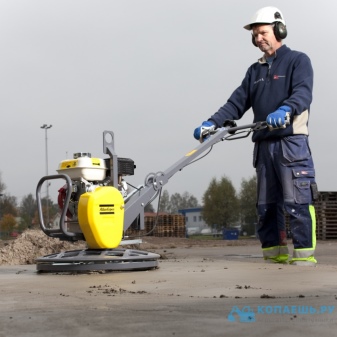

- MQ Whiteman J36H90H. Professional single rotor equipment powered by a 9hp Honda engine. The rotors are capable of speeds of 90-155 rpm. Compact model with 4 blades covered with a protective grill. The device is self-contained, easy to operate.


- Oscar CO-170. Equipped with a 5.5 HP Honda petrol engine. The weight of the machine is 62 kg. The maximum rotational speed of the disks is 136 rpm.
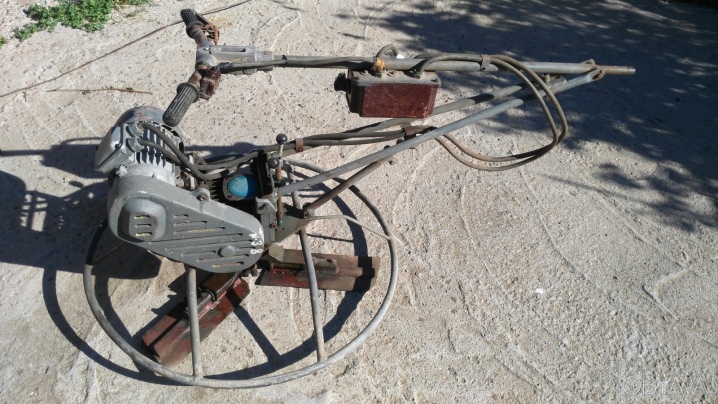
- Norton Clipper CT601 ME. French development. The machine is equipped with 2 types of engines - electric and gasoline Honda GX 120. The unit can be used on large construction sites.It is distinguished by its small size and weight, which makes it easy to transport, operate and store.


- Honker M80S. Inexpensive Czech concrete "helicopter". Equipped with 5.5 hp Sakuma SGE200 petrol engine. It has a reinforced gearbox capable of withstanding heavy loads. Equipped with a folding handle - when assembled it takes up little space, which makes it easy to transport and store.

For the renovation of apartments and small rooms bounded by walls, consumers most often they prefer the following models: Barikell Moskito 4-60, Belle Pro 600 220V, Euro Shatal ST 62E. Among self-propelled variations, the most popular is trowel equipment Coopter Double AS90 and Samsan RPT 361.


Spare parts and components
The main add-ons for concrete trowels are discs and blades. They are available in various sizes and materials.
The discs are designed to work with fresh concrete bases or with cement-sand mortar screeds. Thanks to them, it is possible to produce high-quality primary surface treatment, eliminate curvature, sagging.
Discs are produced with a diameter of 600-1520 mm. The most popular products are available in sizes 710, 750, 880 and 900 mm. Varieties of disks:
- with mounting brackets for 3, 4, 8 or 10 hooks;
- with an edge located at an angle of 45 (for smooth alignment) and 90 degrees (for processing concrete floors near walls).

Many manufacturers offer universal discs - they can be installed on any model of concrete batching machines. For the production of such products, cold-rolled steel is used, which is characterized by high strength and wear resistance. Thanks to these features of the material, the discs can withstand enormous loads.
Trowel blades are used in the final stages of grouting. They have a special design that allows you to achieve a perfectly smooth surface and eliminate unevenness. High-strength steel is used for the manufacture of knives, which is characterized by resistance to wear. The average blade resource is 1500 m2.

Criterias of choice
When buying a "helicopter" for concrete grouting, you need to take into account a number of parameters.
- Engine's type. Gasoline vehicles are maneuverable and productive, they do an excellent job of large volumes of work. However, they are not recommended for indoor use. The use of electrical models is most justified when arranging a screed inside construction sites.
- Power. For solving household tasks, machines with indicators of 4-6 hp are suitable. Professional models are equipped with engines ranging from 10 to 30 hp.
- Type of nozzle (one-rotor or two-rotor modification). Self-propelled devices with two rotors are recommended to be purchased for large-scale industrial work.
- Rotational speed of the disks. The higher the indicator, the more performance the equipment will have.
- Possibility to adjust the angle of inclination of the blades. Machines with this function are convenient and easy to use. Thanks to their quick set-up, they reduce the time to complete the work.
- Irrigation system. Thanks to this function, the quality of the surface finish is significantly improved. Basically, irrigation systems are provided in powerful self-propelled units.
- The presence of emergency locks and switches. They make the operation of the "helicopter" safe for the operator.


When choosing a concrete screed machine, it is recommended to give preference to installations from well-known manufacturers, the quality of whose products is time-tested.
How to work properly?
Concrete grouting is an important process on which the quality of the screed will depend. In order to achieve the desired result, you should use the concrete grouting equipment correctly. The process consists of 2 stages - rough and finishing. It is necessary to act on the surface after 4-20 hours after pouring the concrete. Grouting must be done before the concrete base is completely hardened.Otherwise, the level of dustiness in the work area will increase. When processing completely cured concrete, the blades lose their stability.

It is recommended to grout using a special substance - topping. It is intended for additional strengthening of the concrete base. The solution can be applied by hand.
Coarse grinding is carried out in 2 stages - on the 1st, 2/3 of the topping is used, on the 2nd - the rest. Primary grouting is carried out at low speeds. The second approach is performed perpendicular to the first. Self-propelled vehicles are allowed to be moved in one pass.
Finishing is carried out after 10 hours. It is recommended to use an anti-dust impregnating compound at this stage. Thanks to its use, the concrete base will acquire a solid surface and will not crack when fully hardened and used.














The comment was sent successfully.